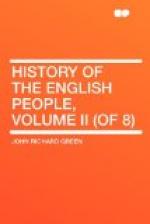to the war, but thirty thousand men followed Edward
to the North, and a host of wild marauders were summoned
from Ireland and Wales. The army which Bruce
gathered to oppose this inroad was formed almost wholly
of footmen, and was stationed to the south of Stirling
on a rising ground flanked by a little brook, the
Bannockburn, which gave its name to the engagement.
The battle took place on the twenty-fourth of June
1314. Again two systems of warfare were brought
face to face as they had been brought at Falkirk, for
Robert like Wallace drew up his forces in hollow squares
or circles of spearmen. The English were dispirited
at the very outset by the failure of an attempt to
relieve Stirling and by the issue of a single combat
between Bruce and Henry de Bohun, a knight who bore
down upon him as he was riding peacefully along the
front of his army. Robert was mounted on a small
hackney and held only a light battle-axe in his hand,
but warding off his opponent’s spear he cleft
his skull with so terrible a blow that the handle of
his axe was shattered in his grasp. At the opening
of the battle the English archers were thrown forward
to rake the Scottish squares, but they were without
support and were easily dispersed by a handful of horse
whom Bruce held in reserve for the purpose. The
body of men-at-arms next flung themselves on the Scottish
front, but their charge was embarrassed by the narrow
space along which the line was forced to move, and
the steady resistance of the squares soon threw the
knighthood into disorder. “The horses that
were stickit,” says an exulting Scotch writer,
“rushed and reeled right rudely.”
In the moment of failure the sight of a body of camp-followers,
whom they mistook for reinforcements to the enemy,
spread panic through the English host. It broke
in a headlong rout. Its thousands of brilliant
horsemen were soon floundering in pits which guarded
the level ground to Bruce’s left, or riding
in wild haste for the border. Few however were
fortunate enough to reach it. Edward himself,
with a body of five hundred knights, succeeded in
escaping to Dunbar and the sea. But the flower
of his knighthood fell into the hands of the victors,
while the Irishry and the footmen were ruthlessly
cut down by the country folk as they fled. For
centuries to come the rich plunder of the English
camp left its traces on the treasure-rolls and the
vestment-rolls of castle and abbey throughout the Lowlands.
[Sidenote: Fall of Lancaster]
Bannockburn left Bruce the master of Scotland: but terrible as the blow was England could not humble herself to relinquish her claim on the Scottish crown. Edward was eager indeed for a truce, but with equal firmness Bruce refused all negotiation while the royal title was withheld from him and steadily pushed on the recovery of his southern dominions. His progress was unhindered. Bannockburn left Edward powerless, and Lancaster at the head of the Ordainers became supreme. But it was still impossible to trust




